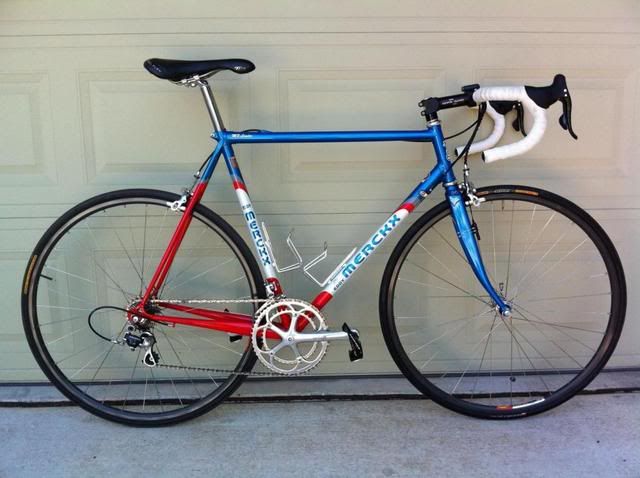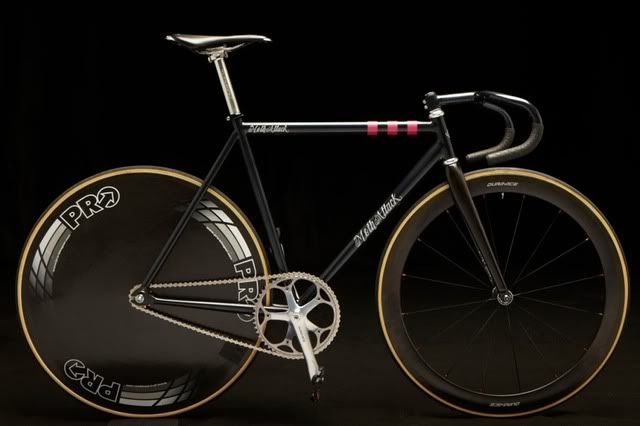-
• #55502
This comment is surely more about your wish to introduce the subject of your stupidity (which you doubtless, stupidly, think amounts to some kind of laudable bravery) in running with bulls than your unconscious stupidity in not knowing that those bars are called bullhorns and therefore do not need to have the resemblance further remarked upon.
All I heard was bla bla I have one ball bla bla >>>>>>>
-
• #55503

-
• #55504
All I heard was bla bla I have one ball bla bla >>>>>>>
so not vastly dissimilar to what we all see in your posts then...
-
• #55505
so not vastly dissimilar to what we all see in your posts then...
Peace, man.
-
• #55506
everyone who tries to make them in ti ends up with lots of unhappy customers
I count myself a happy customer, having had my CQP Ti cranks for 18 years. I think Ti as a material choice for cranks comes with pretty much the same benefits and potential pitfalls as Ti for frames. Making cranks from round tubes is fundamentally sound, yielding the best possible stiffness:weight for any given material. The problems with historic Ti cranks seems to have been a result of trying to hit over-ambitious weight targets rather than any material-specific issue. Given the ratio of physical properties, you'd expect CrMo BMX cranks to fail just as frequently if the manufacturers reduced the wall thickness enough to get the bare crank weight down to about 500g/pr. Several Al and CFRP crank designs have also suffered high failure rates, including models from manufacturers whose R&D budget swamps the total turnover of the small businesses who have turned their hands to Ti cranks.
-
• #55507
light = breaks
strong = heavy
-
• #55508
light = breaks
strong = heavy
Stronglight = heavy + breaks
http://www.lfgss.com/post1154647-24788.html -
• #55509
Stronglight = heavy + breaks
http://www.lfgss.com/post1154647-24788.htmlhow'd you do that?
-
• #55510
weakheavy ? doesnt really work as a bycicle brand name.
they where plastic ? sorry carbon , though............
-
• #55511
how'd you do that?
Not mine, just three different examples of failed Pulsions.
-
• #55512

repost?
-
• #55513

Looks to me like the gauge is too thin for the application considering the combined bending and torsional moments acting in a reciprocal manner, which is typical for a crank. It does look like over ambitious weight targets, as alluded too by mdcc_tester.
I think Ti as a material choice for cranks comes with pretty much the same benefits and potential pitfalls as Ti for frames. Making cranks from round tubes is fundamentally sound, yielding the best possible stiffness:weight for any given material. The problems with historic Ti cranks seems to have been a result of trying to hit over-ambitious weight targets rather than any material-specific issue.
Using round tubes is fundametally correct design principle, but there are very marginal weight gains to be had in tapering the crank down to the pedal and the breakage indicates that it was, essentially, under engineered. From experience, when the depth of a hollow section increases by 40% it doubles the relative strength of the member and looking at the picture, I would estimate that this would be roughly the case in the picture i.e. the strength is twice that immediately adjacent to the bottom bracket axle than where the failure occured by the pedal. In addition, if one element of a stressed member is relatively weaker than another element then it does tend to concentrated the stresses around the weaker areas. Ideally stresses are even throughout a component, although in practice this rarely, if ever, occurs. Traditionally, cranks have always been even in section along their length and I would suggest that this would have been the best option for the crank shown above.
-
• #55514
Given the ratio of physical properties, you'd expect CrMo BMX cranks to fail just as frequently if the manufacturers reduced the wall thickness enough to get the bare crank weight down to about 500g/pr.
I guess most people want to see big weight savings before opening there wallets for a Ti crank. Which encourages poor use of the material.
Tubular steel cranks are things of beauty. I intend to use the Profile racing outboard bearing cranks on something. I dont know what. But they're just lovely.

-
• #55515
Let's hope you have some horse rider legs to cope with the Q factor.
-
• #55516

repost?
This I like.
-
• #55517
More Rossin porn added: Rossin Project
-
• #55518
That's the single best thing Morrissey has ever done.
I thought that was vanilla ice!
-
• #55519
Let's hope you have some horse rider legs to cope with the Q factor.
Ha. I thought the exact same thing.
I like to keep Q-factor down TBH (tiny legs). But I was looking at the internal bearing version of those cranks for the fatbike build. Where stuff like Q-factor, and weight are fecked before you even start.
-
• #55522
Please post the thousands of cracked and broken Shimano and "no name" cranks too, please!
Incl. 10sp Dura Ace...Especially the cast aluminium ones.
-
• #55523
needs more bikes
-
• #55524
Please post the thousands of cracked and broken Shimano and "no name" cranks too, please!
Incl. 10sp Dura Ace...Especially the cast aluminium ones.
7800 or 7900?
-
• #55525
Please post the thousands of cracked and broken Shimano and "no name" cranks too, please!
Incl. 10sp Dura Ace...Especially the cast aluminium ones.
- From the collection of Ric Hjertberg.
- Welded tubular steel failure, Bullseye
- Welded steel failure, Tioga Revolver
- Split along square taper, Campagnolo
- Non-failed Sweet Wings crank
- Carbon crank fails parallel to chain line, Colnago
- Vintage crank failures, aluminum Campagnolo
- Failure away from features, Dura-Ace
- Race Face arm failure away from features
- Failure at pedal eye, newer Campagnolo Super Record
- Crack at spider/arm transition, Cannondale Coda ``Magic''
- Arm failure at pedal eye, older Campagnolo
- Arm failure at pedal eye, older Shimano Dura-Ace, replacement with Jobst Brandt collet
- Arm failure at square taper, late 1990's Topline
- Square taper failure, Grafton Joystix
- Separation at glue line, hollow CODA/Magic
- Middle of arm, Campagnolo c. 2002
- Hollow crank failure at end of hollow section
- Pedal eye failure despite use of pedal washer
- Arm failure at square taper, Topline
- Arm failure at end of groove, partial failure both arm/spider transitions; 1970's Campagnolo
- Failed Sweet Wings spider
- 1970's crank failures: T.A., Stronglight, 2x Campagnolo.
- CODA Magic hollow crank separation at glue line
- Tubular steel crank failure at pedal eye, Bullseye
- Two crank failures, one rider: Race Face Isis Turbine LP, Race Face Next LP
- Crank failure, C-section arm
- Crank failure, hollow arm
- Crank failure, left-side square taper, away from crank
- Crank failure, at pedal eye
- Truvative Styleo Team, near spider
- Failure at spider/crank transition
- Presumed failure at spider/crank transition
- Bontrager aluminum crank failure in rounded section
- Failures of three "vintage" cranks of unknown history
- Campagnolo "Grand Sport" failed near pedal eye
- T.A. crank failed on vanity groove near spindle
- Bontrager crank failed on vanity groove
- Campagnolo crank failure at pedal eye
- From the collection of Ric Hjertberg.
 ObiWomKenobi
ObiWomKenobi Jon.
Jon. spotter
spotter gbj_tester
gbj_tester willejp
willejp Smallfurry
Smallfurry Regal
Regal ElPrez
ElPrez Balki
Balki
 Dutch_Cheese
Dutch_Cheese O'Shane
O'Shane @Velocio
@Velocio
what he said ^ love titanium but it's a silly material for cranks - alloy or carbon is more than capable for the job and everyone who tries to make them in ti ends up with lots of unhappy customers